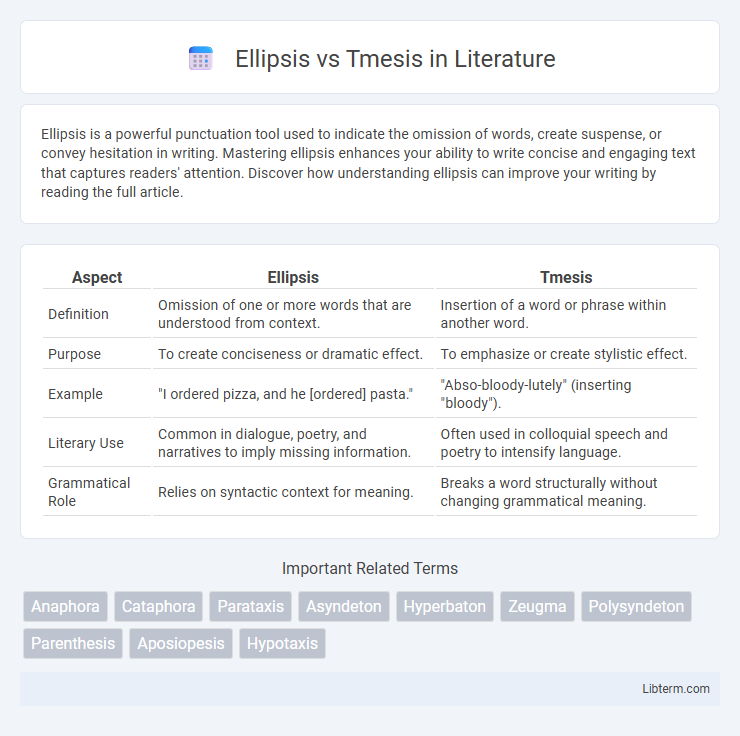Ellipsis is a powerful punctuation tool used to indicate the omission of words, create suspense, or convey hesitation in writing. Mastering ellipsis enhances your ability to write concise and engaging text that captures readers' attention. Discover how understanding ellipsis can improve your writing by reading the full article.
Table of Comparison
| Aspect | Ellipsis | Tmesis |
|---|---|---|
| Definition | Omission of one or more words that are understood from context. | Insertion of a word or phrase within another word. |
| Purpose | To create conciseness or dramatic effect. | To emphasize or create stylistic effect. |
| Example | "I ordered pizza, and he [ordered] pasta." | "Abso-bloody-lutely" (inserting "bloody"). |
| Literary Use | Common in dialogue, poetry, and narratives to imply missing information. | Often used in colloquial speech and poetry to intensify language. |
| Grammatical Role | Relies on syntactic context for meaning. | Breaks a word structurally without changing grammatical meaning. |
Understanding Ellipsis: Definition and Examples
Ellipsis is a linguistic phenomenon where one or more words are omitted from a sentence because they are implied by the context, enhancing brevity and cohesion in communication. For example, in the sentence "She can play the guitar, and he can too," the phrase "play the guitar" is omitted after "he can" but understood by the listener. This contrasts with tmesis, which involves the insertion of a word or phrase within another word, showcasing different syntactic manipulation in language.
Tmesis Explained: Breaking Down the Concept
Tmesis is a linguistic phenomenon where a word or phrase is inserted between parts of another word or phrase, breaking it into two segments for emphasis or rhetorical effect. Unlike ellipsis, which involves omitting parts of a sentence to avoid redundancy, tmesis deliberately splits compound words or fixed expressions, such as "abso-bloody-lutely" or "fan-bloody-tastic." This device is often used in poetry and colloquial speech to create emphasis, humor, or a dramatic pause within the structure of language.
Key Differences Between Ellipsis and Tmesis
Ellipsis involves the omission of one or more words that are understood from the context, enhancing brevity and cohesion in sentences. Tmesis, on the other hand, refers to the insertion of a word or phrase within another word, often for emphatic or stylistic effect, such as "abso-bloody-lutely." The key differences lie in ellipsis omitting elements for conciseness, while tmesis disrupts word structure to create emphasis or humor.
Historical Origins of Ellipsis and Tmesis
Ellipsis, rooted in ancient Greek rhetoric, originated as a stylistic device to omit words that are understood from context, enhancing brevity and impact in classical literature and oratory. Tmesis, also tracing back to classical antiquity, involves the intentional insertion of a word or phrase within another word to create emphasis or stylistic effect, commonly found in Latin and early English poetry. Both ellipsis and tmesis reflect historical linguistic strategies that highlight the flexibility and creativity in language use dating from classical to medieval periods.
Common Uses of Ellipsis in Modern Writing
Ellipsis commonly appears in modern writing to indicate omitted information, create suspense, or reflect natural speech patterns, enhancing readability and engagement. It frequently serves in dialogue to show pauses, hesitation, or trailing off thoughts, mimicking authentic communication. Writers also use ellipsis to condense quotes or avoid redundancy while preserving meaning and flow.
Notable Instances of Tmesis in Literature
Tmesis, the insertion of a word or phrase within another word, appears notably in Shakespearean works such as "What light through yonder window breaks?" from Romeo and Juliet, where "what light" breaks apart the phrase "window breaks." Another remarkable example is found in "un-bloody-valiant," from Macbeth, showcasing creative emphasis through word division. These instances highlight tmesis as a poetic device enhancing rhythm and meaning in classical literature.
Ellipsis in Everyday Speech and Communication
Ellipsis in everyday speech serves as a powerful tool for efficient communication by omitting redundant words or phrases, allowing speakers to convey meaning quickly and naturally. Common examples include responses like "Want some?" where the verb "do you" is omitted, yet clearly understood. This linguistic feature enhances conversational flow and reduces cognitive load, making interactions more fluid and contextually rich.
Tmesis in Poetry and Creative Expression
Tmesis, the deliberate insertion of a word or phrase between parts of a compound word, serves as a powerful poetic device to create emphasis and rhythmic variation, distinguishing it from ellipsis, which involves the omission of elements for brevity. In poetry, tmesis enhances expressiveness by breaking conventional word boundaries, allowing poets like Shakespeare and contemporary authors to play with language and evoke stronger imagery or emotional impact. This creative manipulation of language highlights tmesis as a tool for innovation within poetic structure and stylistic expression.
Comparing Grammatical Functions: Ellipsis vs. Tmesis
Ellipsis functions by omitting parts of a sentence that are understood from context, streamlining communication while maintaining grammatical coherence. Tmesis, conversely, involves the insertion of a word or phrase within another, often disrupting the standard syntactic structure for emphasis or stylistic effect. The primary grammatical distinction lies in ellipsis preserving the sentence's overall syntax through omission, whereas tmesis modifies the internal composition of words or phrases without omitting elements.
Practical Tips for Using Ellipsis and Tmesis Effectively
Ellipsis involves omitting words that are implied by context, enhancing sentence conciseness and fluidity, while tmesis inserts a word or phrase within another word for emphasis or stylistic effect. Practical tips for using ellipsis effectively include ensuring the omitted words are clearly understood to avoid ambiguity and maintaining grammatical coherence. Employ tmesis sparingly in writing to create a playful or dramatic tone without confusing the reader, often found in poetry, advertising, or informal speech.
Ellipsis Infographic

 libterm.com
libterm.com